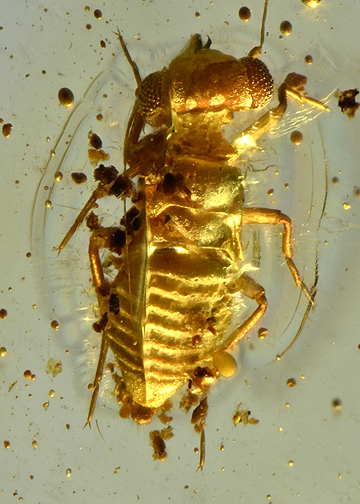Abstract
Camouflage, or decorating, has been reported in fossilised immatures of different insect groups, notably Neuroptera (Chrysopidae, Nymphidae, and Ascalaphidae), Coleoptera (Chrysomelidae), Trichoptera, Lepidoptera, Hemiptera (Gelastocoridae, Reduviidae), and Psocodea (‘Psocoptera’ or non-parasitic lice) (Pérez-de la Fuente et al., 2012; Wang et al., 2016; Kiesmüller et al., 2021; Xu et al., 2021). Such behaviours allow effective concealment of immatures from predators and/or prey by carrying vegetal debris, soil, dust and, sometimes, arthropod remains on the thorax and/or abdomen.
References
- Azar, D., Gèze, R. & Acra, F. (2010) Chapter 14. Lebanese amber, pp. 271–298. In: Penney, D. (Ed.), Biodiversity of fossils in amber from the major world deposits. Siri Scientific Press, Manchester, 304 pp.
- Betz, B.W. (1983) The biology of Trichadenotecnum alexanderae Sommerman (Psocoptera: Psocidae): I. Habitat, life stages and events. Entomological News, 94 (4), 152–158.
- Boucot, A.J. & Poinar, G.O., Jr. (2010) Fossil behavior compendium. CRC Press, Boca Raton, Florida, 424 pp. https://doi.org/10.1201/9781439810590
- Henderson, A. & Hackett, D.J. (1986) Lichen and algal camouflage and dispersal in the psocid nymph Trichadenotecnum fasciatum. The Lichenologist, 18 (2), 199–200. https://doi.org/10.1017/S0024282986000257
- Kiesmüller, C., Haug, J.T., Müller, P. & Hörnig, M.K. (2021) Debris carrying behaviour of bark lice immatures preserved in 100 million years old amber. PalZ, 96, 231–258. https://doi.org/10.1007/s12542-021-00567-6
- Lienhard, C. (1988) Three new extra-neotropical species of Troctopsocidae (Insecta: Psocoptera). Journal of Natural History, 22 (3), 575–587. https://doi.org/10.1080/00222938800770391
- Lienhard, C. (1998) Psocoptères euro-méditerranéens. Faune de France, 83, i–xx, 1–517.
- Lienhard, C. & Baz, A. (2011) Redescription of the genus Marcenendius Navás (Psocodea: Psocoptera: Amphientomidae) with a key to western Palaearctic amphientomids. Revue Suisse de Zoologie, 118 (3), 451–466.
- Maksoud, S. & Azar, D. (2020) Lebanese amber: latest updates. Palaeoentomology, 3 (2), 125–155. https://doi.org/10.11646/palaeoentomology.3.2.2
- Maksoud, S., Azar, D., Granier, B. & Gèze, R. (2017) New data on the age of the Lower Cretaceous amber outcrops of Lebanon. Palaeoworld, 26 (2), 331–338. https://doi.org/10.1016/j.palwor.2016.03.003
- Mockford, E.L. (1974) Trichadenotecnum circularoides (Psocoptera: Psocidae) in Southeastern United States, with notes on its reproduction and immature stages. The Florida Entomologist, 57 (4), 369–370. https://doi.org/10.2307/3493496
- Mockford, E.L. (1993) North American Psocoptera (Insecta). Fauna and Flora Handbook no. 10. CRC Press, Boca Raton, Florida, 480 pp.
- Pérez-de la Fuente, R., Delclòs, X., Peñalver, E., Speranza, M., Wierzchos, J., Ascaso, C. & Engel, M.S. (2012) Early evolution and ecology of camouflage in insects. Proceedings of the National Academy of Sciences of the United States of America, 109 (52), 21414–21419. https://doi.org/10.1073/pnas.1213775110
- Smithers, C.N. (1972) The classification and phylogeny of the Psocoptera. The Australian Museum Memoir, 14, 1–351. https://doi.org/10.3853/j.0067-1967.14.1972.424
- Smithers, C.N. (1995) Final instar nymph of Psilopsocus nebulosus Mockford (Psocoptera: Psilopsocidae), redescribed and compared with two wood-boring species of the genus. Beiträge zur Entomologie, 45 (2), 375–381. https://doi.org/10.21248/contrib.entomol.45.2.375-381
- Wang, B., Xia, F.Y., Engel, M.S., Perrichot, V., Shi, G.L., Zhang, H.C., Chen, J., Jarzembowski, E.A., Wappler, T. & Rust, J. (2016) Debris-carrying camouflage among diverse lineages of Cretaceous insects. Science Advances, 2 (6), e1501918. https://www.science.org/doi/10.1126/sciadv.1501918
- Xu, C.P., Wang, B., Fan, L., Jarzembowski, E.A., Fang, Y., Wang, H., Li, T., Zhuo, D., Ding, M. & Engel, M.S. (2021) Widespread mimicry and camouflage among mid-Cretaceous insects. Gondwana Research, 101, 94–102. https://doi.org/10.1016/j.gr.2021.07.025


